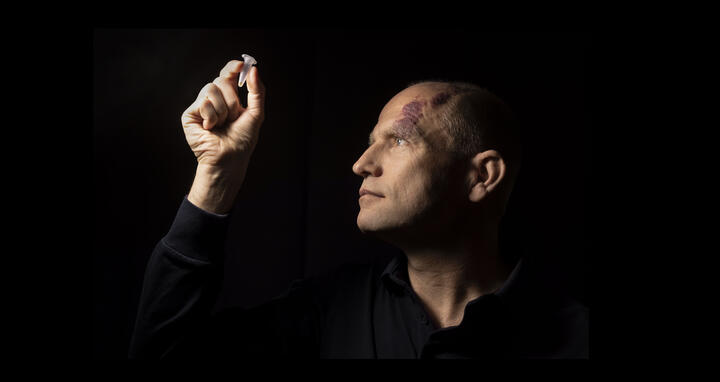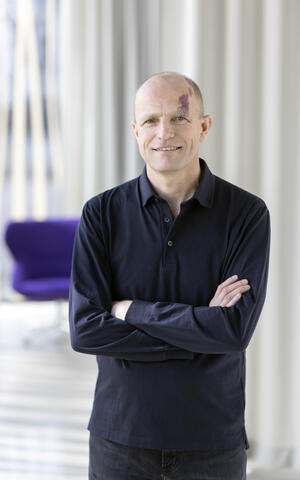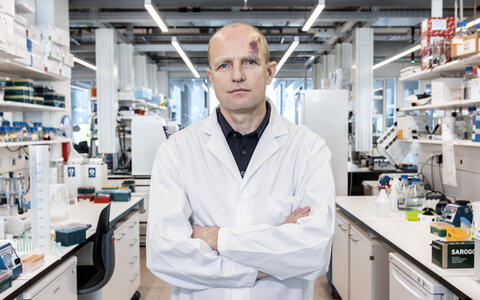The RNA profiler
If only genetic processes were a bit more remarkable, then more people would understand how important they are. Professor Markus Landthaler holds a reaction tube between his thumb and index finger. It is filled with a clear liquid. “Much of what we do takes place in plastic tubes like this,” he says, and puts it back in its holder. The solution contains RNA-binding proteins that interact with the ribonucleic acid (RNA) inside cells. These seemingly unremarkable proteins are essential for the creation of new, vital proteins according to instructions encoded in genes, a process called gene expression.
In a neighboring room, a lab worker tends to human liver cells growing in a petri dish. Landthaler and his team continually grow various types of human cells, transfer them to reaction tubes, isolate the RNA-binding proteins they contain, and analyze and biochemically manipulate them. “We observe exactly what RNA-binding proteins do in cells, what they interact with, and what role they play in cell function, including in diseases.” Whether or not a single one of these important protein types properly performs its functions during gene expression can determine if viruses like dengue fever or SARS-CoV-2 are able to spread in the body.
Research trailblazer, puzzle solver and craftsman
Markus Landthaler
Markus Landthaler, head of the RNA Biology and Posttranscriptional Regulation Lab at the Berlin Institute for Medical Systems Biology of the Max Delbrück Center (MDC), has dedicated his career to basic research. He is a trailblazer in the world of gene expression, which so far no one has understood in its full complexity. He is a puzzle solver, determined to piece together the tiniest fragments of gene regulation. And he is a craftsman who develops methods for discovering these fragments and understanding them.
The processes involved in gene expression can be imagined like finely tuned cogs in a machine. A machine that continually produces proteins – and thus life. Production begins when individual sections of the genome are read by genes and transcribed as ribonucleic acid (RNA). This process is called transcription. Landthaler focuses particularly on the processes that come next. As he explains, “The RNA then practically takes on a life of its own and interacts with RNA-binding proteins.” In translation, which occurs outside the cell nucleus in the surrounding cytoplasm, the RNA – now in the form of messenger RNA (mRNA) – acts as a blueprint used by ribosomes to synthesize proteins from amino acids. The focus of Landthaler’s attention, the RNA-binding proteins, make sure that mRNA is transported from the cell nucleus, is guided to the ribosome, stabilizes, and can be broken down again when it is no longer necessary. “The whole life cycle of mRNA is determined by which of these proteins it surrounds itself with,” Landthaler says.
It all started with bacteriophage RNA
Landthaler’s first big experiment immediately got him hooked on RNA and the processes that surround it. Initially, he got interested in ethology while studying biology at the University of Würzburg. “But it never sat right with me that ants can’t be manipulated as well as nucleic acid,” he says. So he switched to molecular biology, whose mechanisms interlock like puzzle pieces. While studying abroad at the State University of New York, he isolated RNA from bacteria infected with special viruses called phages. And he looked for chunks of RNA (introns) that can remove themselves. “That’s where it all started. After that, I could never really tear myself away from RNA.”
In 2003, he went to Rockefeller University in New York, where Professor Thomas Tuschl, a molecular biologist, was in the process of describing RNA interference. RNA interference plays a role in cleaving and silencing mRNA. As a postdoc, Landthaler and his colleague Markus Hafner developed a method, called PAR-CLIP, for determining the exact nucleotide on which RNA-binding proteins interact with RNA. “For the first time,” Landthaler says, “it allowed us to map in high resolution the interaction of all RNA-binding proteins with RNA in a cell. We also succeeded in disabling specific proteins and seeing what happened to the RNA – was it stabilized, was more of it synthesized, or was its breakdown accelerated?”
When Landthaler came to Berlin to join the MDC in 2009, about 700 proteins were known that communicate with RNA. By 2012, his team had discovered an additional 250. “Today we are familiar with about 1,800 RNA-binding proteins that are encoded in the human genome. They control a large number of regulatory mechanisms,” Landthaler says. “We know where about one-third of them bind to RNA and what their jobs are.”
Markus Landthaler
Landthaler’s work is relevant both to molecular biology and increasingly to biological and applied research. Among other things, he wants to find out which RNA-binding proteins are active in the repair of DNA damage after exposure to radiation, and which ones play a role in the reproduction of herpes simplex viruses in human cells.
How do individual cells react to an infection?
In 2016, Landthaler and Professor Nikolaus Rajewsky used single cell sequencing to observe more than 12,000 human cells during a herpes infection. “We discovered a group of cells in which the virus could not reproduce,” Landthaler says. He and Rajewsky realized that a transcription factor known as NRF2, which is activated during cellular stress, was preventing the virus’s multiplication in these cells. “Singe cell sequencing is a major advance,” Landthaler says. “For the first time we can see how thousands of different individual cells react to a viral infection and how the virus develops in them.”
That includes SARS-CoV-2, which started the pandemic in late 2019. As the leader of a task force, Landthaler coordinates research on the novel coronavirus at the MDC; he receives cells infected with SARS-CoV-2 from Christian Drosten at Charité – Universitätsmedizin Berlin. Using single-cell sequencing, they have found a protein, HSP90, that helps the virus. “We then added HSP90 inhibitors to the cell culture and saw that SARS-CoV-2 multiplied much less,” Landthaler says. They also discovered that these inhibitors blocked native immune defenses and at the same time reduced inflammation. “By adding such inhibitors at just the right time in animal experiments, we are able to attenuate inflammation in the lungs.” Landthaler’s team is now continuing this research as part of the Helmholtz consortium CoViPa. It could potentially end up being a component in COVID-19 therapy.

As clever as biology itself
That is what my research is all about, that is why I devote myself to increasingly complex questions, formulate hypotheses, and try to be as clever as biology itself.
Yet it is still the great puzzle of basic research that fascinates Landthaler the most. New methods enable him to observe even smaller fragments than before, such as proteins that are active in individual cell compartments like the endoplasmic reticulum, in which a part of mRNA is translated into proteins. One of the things Landthaler is investigating there is the interaction between the protein HDLBP and mRNA. “We have discovered that HDLBP can increase protein production,” Landthaler says. “The mechanism behind it is not yet entirely clear, but I won’t give up until I have grasped it.” What is already clear is that HDLBP can be used to enhance the production of therapeutic proteins.
Landthaler expects many more discoveries to be made in the field of RNA and RNA-binding proteins. Slowly but surely, scientists are paying closer attention to the variety of other types of RNA such as tRNA and snoRNA. They are also coming to realize that not all cells have the same RNA profile, nor do cells have the same RNA profile in all the phases of their life. Landthaler also plans to use mathematical models to predict how many proteins are produced in cells under the influence of specific RNA-binding proteins. This would help us to better understand and perhaps even reverse pathological changes in gene expression. “That is what my research is all about,” he says. “That is why I devote myself to increasingly complex questions, formulate hypotheses, and try to be as clever as biology itself – and hopefully get it right sometimes.”
Text: Mirco Lomoth
Further information








